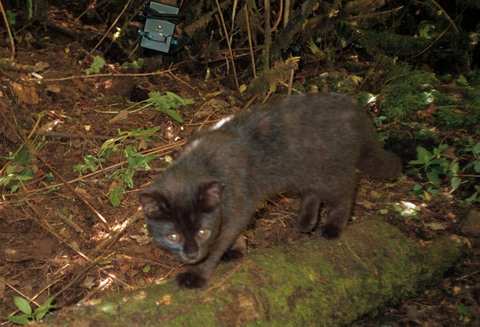Adaptation
Leopardus guigna is among one of smallest cats in
the world. They are approximately the same size as domestic
cats, ranging anywhere from 17-29 cm tall and (including tail)
50-68 cm long. Kodkods weigh approximately 2.2 kg. Their coat
can either be grey or brown with no spots or with black spots
(Freer 2004).
According to Freer (2004), kodkods diets consist of mostly
birds, forcing them to be extremely agile tree climbers with
sharp claws for gripping and a light figure to make climbing
trees easier. They are also known to hide their young away in
trees to protect them from predation. Along with a heavy diet of
birds, kodkod also hunt similar small prey such as rats or even
the occasional, much larger, goose.
Slater and Valkenburgh (2009) state that felids typically kill
their prey with a neck bite, using their two large canines to
penetrate the skin. Due to this, cats with larger jaws can
capture larger prey. This, however, is not the case with
kodkods. With their small stature and acute jaw, they must adapt
their diet to animals with small throats such as rodents and
birds. Additionally, because they don’t have as thick of a skull
as larger cats, kodkods avoid taking down larger prey that could
potentially smash in their skull.
Kodkods, like most felids, have an extremely heightened sense of
sound and sight. They primarily hunt at night, so their
forward-facing, rounded ears help them stalk their prey and also
prevent them from being stalked by larger predators. The oval
shaped “cat eye” pupil, of kodkods, can adjust to light quicker
than a round pupil. This unique pupil shape is also more
sensitive to movement. This is beneficial when kodkods are
hunting. They can see animals better in their peripherals.
and sight. They primarily hunt at night, so their
forward-facing, rounded ears help them stalk their prey and also
prevent them from being stalked by larger predators. The oval
shaped “cat eye” pupil, of kodkods, can adjust to light quicker
than a round pupil. This unique pupil shape is also more
sensitive to movement. This is beneficial when kodkods are
hunting. They can see animals better in their peripherals.
Figure 4. This image is of a melanistic kodkod (not spotted).
It can
be found at
Animal Diversity Web.
Leopardus guigna cannot easily stretch its forearms and legs to their full length (Andersson 2004). These limbs have joints that are designed to be able to store a lot of energy, so when they are chasing after prey or running from a predator, they can push off with an extreme amount of force. They can only repeat this action for short bursts of time. These cats are short distance sprinters due to their rare elbow-joint design. Furthermore, the strength of the forearms depicts what animals a kodkod can attack (Meachen-Samuels and Van Valkenburgh 2009). Along with the size and strength of the jaw, the forearms of the kodkod must be able to control and hold down the prey in order to kill it. Kodkods do have longer forearms than felids larger than them, but these bones are not as thick, and therefore, do not frequently attack prey larger than themselves.
The tail of most animals is used primarily for balance; this is no different for the kodkod. Kodkods use their tail very much for balance, but many observations have also shown that the movement of a cat’s tail can display their emotions (Kiley-Worthington 1976). Just before a kodkod is about to attack an animal, it may whip its tail back and forth out of excitement. A felid may also acknowledge another cat by raising its tail straight up.
Head to the reproduction page for more information, or go back to the homepage.